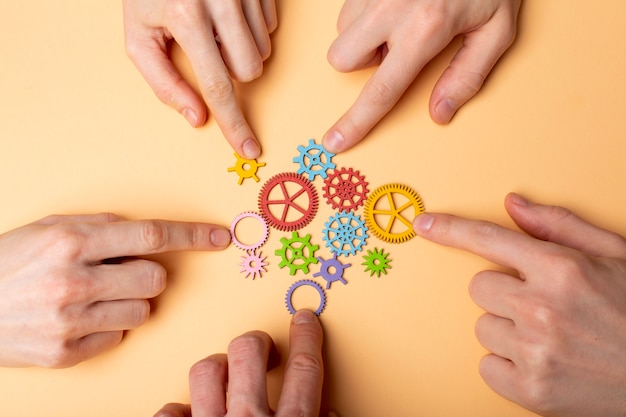Additive manufacturing, commonly known as 3D printing, is a rapidly evolving technology transforming various industries. This comprehensive guide provides a detailed exploration of the process, from initial design concepts to post-processing techniques. It covers essential hardware components, software applications, material selection, troubleshooting common issues, and safety considerations. Successfully operating a 3D printer requires understanding the intricacies of the technology and adhering to best practices for optimal results. This guide aims to equip readers with the knowledge and skills necessary to achieve proficiency in this exciting field.
I. Understanding 3D Printing Technology

A. Additive Manufacturing Processes

Several additive manufacturing techniques exist, each with unique capabilities and limitations. The most common methods include:
- Fused Deposition Modeling (FDM): This method extrudes molten thermoplastic filament layer by layer to build a three-dimensional object. It is relatively inexpensive and accessible for hobbyists and small businesses.
- Stereolithography (SLA): SLA uses a UV laser to cure liquid photopolymer resin, creating highly detailed and accurate parts. This technique excels in producing smooth surfaces and intricate geometries but requires careful handling of the resin and post-curing processes.
- Selective Laser Sintering (SLS): SLS uses a high-powered laser to fuse powdered material, typically nylon or metal, layer by layer. This method is suitable for creating strong and durable parts with complex internal structures, although the process is more expensive and requires specialized equipment.
- Selective Laser Melting (SLM): Similar to SLS, but SLM uses a laser to melt metal powder, producing highly precise metal parts with excellent mechanical properties. This technique is frequently used in aerospace and medical applications.
B. Key Components of a 3D Printer

Regardless of the printing technology employed, most 3D printers share common essential components:
- Frame: The structural foundation of the printer, providing stability and support for the moving parts.
- Print Bed/Platform: The surface where the object is built. Its temperature and leveling are crucial for print adhesion.
- Extruder/Nozzle (FDM): Melts and extrudes the filament in FDM printers. Precision is essential for consistent layer deposition.
- Build Plate/Platform (SLA/SLS/SLM): Holds the build material (resin or powder) and facilitates the layer-by-layer construction process.
- Motion System: Typically comprises stepper motors and belts or screws, enabling precise movement of the extruder/build platform in the X, Y, and Z axes.
- Control Board: The central processing unit, managing all aspects of the printing process based on the instructions from the software.
- Power Supply: Provides the necessary power to operate the various components.
II. The 3D Printing Workflow
A. Digital Design and Modeling
The process begins with a digital design. Popular software options include:
- Tinkercad: A beginner-friendly, browser-based CAD software suitable for simple designs.
- Fusion 360: A powerful and versatile CAD/CAM software package offering a wide range of design tools.
- Blender: A free and open-source 3D modeling software primarily used for animation but capable of creating printable models.
- SolidWorks: A professional-grade CAD software widely used in engineering and manufacturing.
Important Considerations: Designs must be carefully created to ensure printability. This includes factors such as wall thickness, overhang angles, and support structures. The design file needs to be exported in a format compatible with the slicer software, typically STL (Stereolithography) or OBJ (Wavefront OBJ).
B. Slicing the Model
Slicing software converts the 3D model into instructions understood by the 3D printer. Popular options include:
Read Also: Connect to Canon Printer: A Simple Guide – Printing Test Pages
- Cura: A widely used, open-source slicer offering a user-friendly interface and extensive customization options.
- PrusaSlicer: Known for its accuracy and ease of use, particularly for FDM printing.
- Simplify3D: A commercial slicer with advanced features for fine-tuning print parameters.
The slicing process involves setting various parameters that influence print quality, including layer height, infill density, nozzle temperature, print speed, and support structure generation. Careful adjustment of these parameters is essential for achieving optimal results. The output of the slicer is typically a G-code file.
III. Preparing for a Print
A. Material Selection
The choice of material significantly affects the final product’s properties. Common materials for FDM include:
- PLA (Polylactic Acid): A common, biodegradable material easy to print with and relatively inexpensive.
- ABS (Acrylonitrile Butadiene Styrene): A stronger and more heat-resistant material than PLA, but requires a heated print bed.
- PETG (Polyethylene Terephthalate Glycol-modified): Offers better strength, durability, and moisture resistance than PLA.
- TPU (Thermoplastic Polyurethane): A flexible material suitable for creating rubber-like parts.
Resin-based materials (SLA/DLP) offer a wide range of properties, including high detail and strength. Metal powders (SLS/SLM) are used to create strong and durable metallic parts.
B. Printer Setup and Calibration
Proper setup and calibration are paramount for successful printing. This includes:
- Leveling the print bed: Ensuring the print bed is perfectly level is critical for good first-layer adhesion.
- Nozzle height adjustment (FDM): The distance between the nozzle and the print bed needs to be precisely calibrated.
- Temperature settings: Optimizing the nozzle and bed temperatures is essential for achieving consistent extrusion and adhesion.
- Belt tension adjustment: Proper belt tension ensures smooth and accurate movement of the extruder/print bed.
- Firmware updates: Regularly updating the printer’s firmware can enhance performance and stability.
C. Loading Filament/Resin
The procedure for loading filament or resin varies depending on the printer type. Always consult the manufacturer’s instructions for specific details. Correct loading is crucial for avoiding clogs or inconsistencies in the printing process.
IV. The Printing Process
A. Initiating the Print
Once the model is sliced and the printer is properly calibrated, the G-code file can be sent to the printer through the appropriate software interface. The printing process will begin automatically, creating the object layer by layer.
B. Monitoring the Print
It’s recommended to monitor the print throughout the process. Observing for any unusual sounds, smells, or visual anomalies can help identify potential problems early on. Most printers offer monitoring options through software interfaces.
C. Troubleshooting Common Issues
Common issues encountered during printing include:
- Adhesion problems: Poor adhesion can be caused by an unlevel print bed, incorrect temperature settings, or dirty nozzle.
- Layer shifting: This occurs when the layers are not properly aligned, often due to loose belts or other mechanical issues.
- Clogging: Clogged nozzles are usually caused by moisture in the filament or incorrect temperature settings.
- Stringing/Oozing: Excessive material between layers, often caused by incorrect retraction settings or too high a temperature.
- Warping: Curling of the edges of the print, often caused by uneven cooling or insufficient bed adhesion.
Troubleshooting involves careful examination of the print and systematic adjustments to the printing parameters or mechanical components.
V. Post-Processing and Finishing
A. Removing Supports
Many designs require support structures to ensure successful printing of overhanging sections. These supports must be carefully removed after the print is completed. Improper removal can damage the printed part.
B. Cleaning and Finishing
Post-processing steps might include:
- Cleaning: Removing excess material or support structures from the printed part.
- Sanding/Filing: Smoothing out surface imperfections.
- Painting/Coating: Adding color or protective coatings.
- Post-curing (SLA/DLP): Exposing resin prints to UV light to fully cure the material.
The specific post-processing steps depend on the printing technology used and the desired final result.
VI. Safety Considerations
Safety is paramount when operating a 3D printer. Precautions include:
- Proper ventilation: Ensure adequate ventilation to remove fumes and particles generated during the printing process.
- Eye protection: Wear safety glasses to protect eyes from flying debris.
- Heat safety: Be mindful of hot surfaces, especially the nozzle and print bed.
- Material handling: Handle materials carefully to avoid skin irritation or inhalation of particles.
- Fire safety: Keep flammable materials away from the printer and ensure proper electrical safety.
Always consult the manufacturer’s safety guidelines and follow best practices to prevent accidents.
VII. Applications and Benefits of 3D Printing
The applications of 3D printing are vast and constantly expanding. Its benefits include:
- Rapid prototyping: Creating prototypes quickly and cost-effectively.
- Customization: Producing highly customized products tailored to individual needs.
- On-demand manufacturing: Producing parts only when needed, reducing inventory costs.
- Complex geometries: Creating parts with intricate designs impossible to manufacture using traditional methods.
- Material diversity: Utilizing a wide range of materials with varying properties.
- Reduced tooling costs: Eliminating the need for expensive molds and tooling.
- Distributed manufacturing: Decentralizing production, enabling local manufacturing capabilities.
Industries leveraging 3D printing include aerospace, healthcare, automotive, education, and consumer goods. The technology’s potential for innovation and disruption continues to grow exponentially.
VIII. Conclusion: The Future of Additive Manufacturing
3D printing is more than a mere technological advancement; it’s a paradigm shift in manufacturing and design. By understanding the principles and best practices outlined in this guide, individuals and organizations can unlock the vast potential of additive manufacturing. As the technology continues to mature, further advancements in materials, software, and hardware can be expected, leading to even wider adoption and transformative applications across diverse industries.

